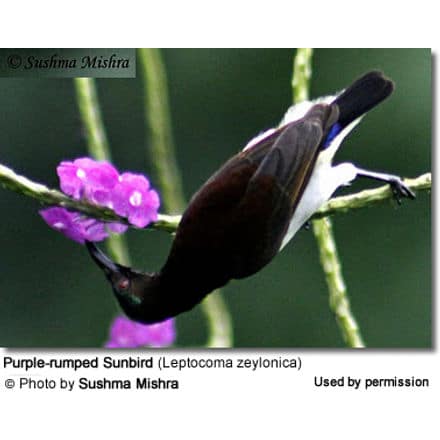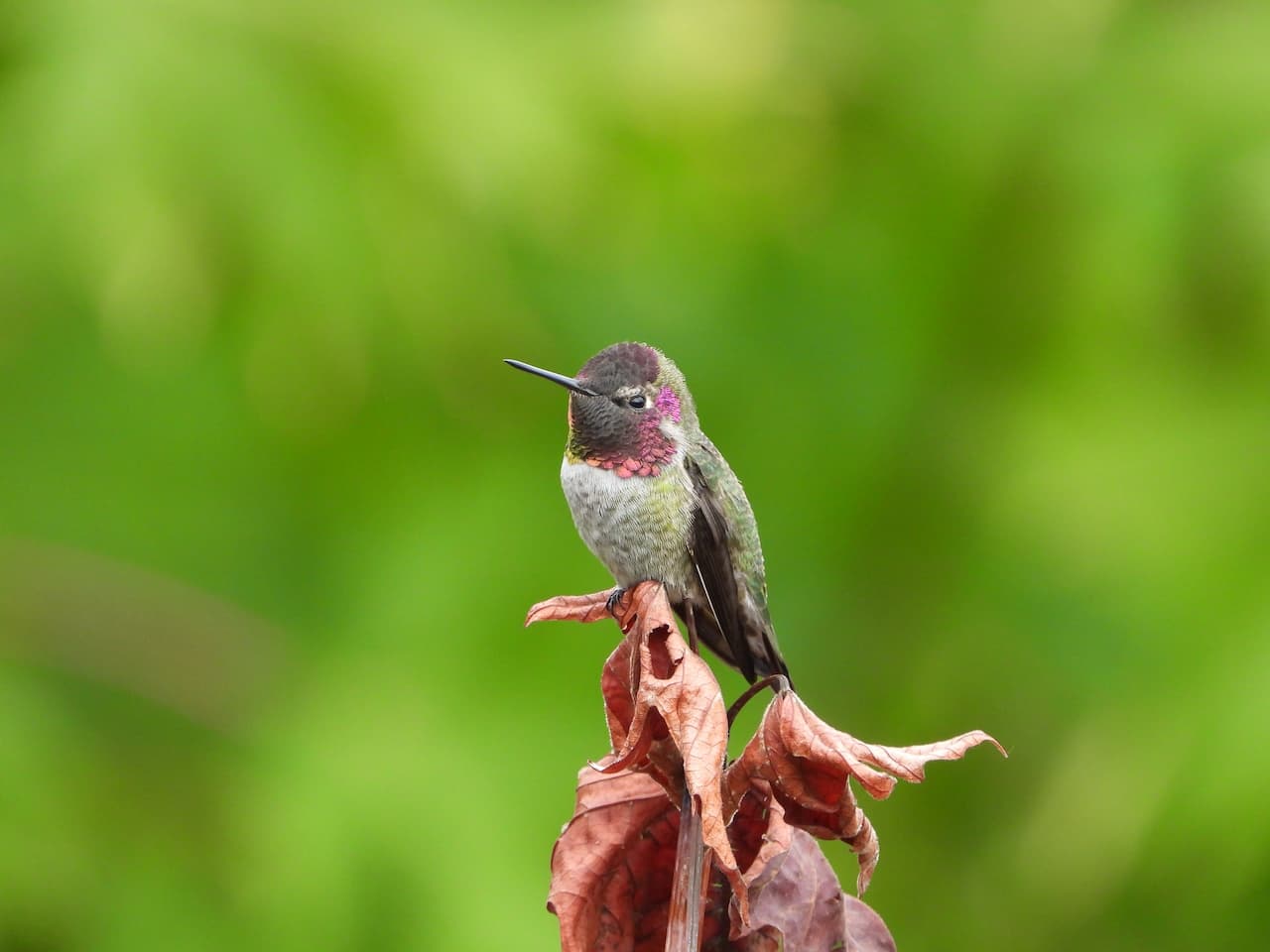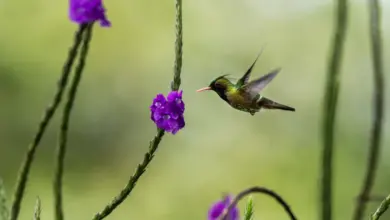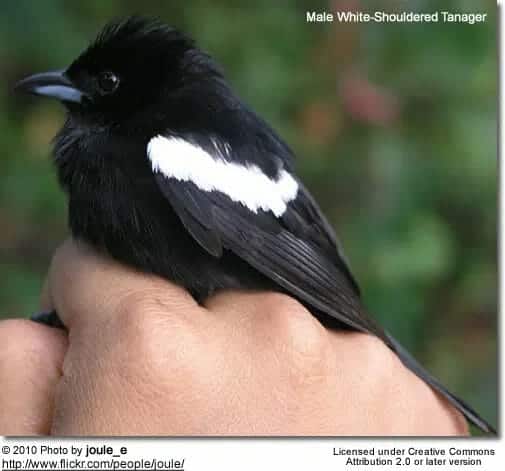Purple-rumped Sunbirds
The Purple-rumped Sunbirds (Leptocoma zeylonica) – also known as Small Sunbirds, in reference to their size – are nectar-eating sunbirds that are endemic to the Indian Subcontinent.
These hummingbird-sized birds are commonly observed feeding on bright-colored flowers, dew-bathing, or bathing by sliding in drops of rain collected on large leaves. When breeding, the female is often seen collecting cobwebs, while the male flies besides her.
Alternate (Global) Names
Chinese: ????? … Czech: strdimil srílanský, Strdinil cejlonský … Danish: Indisk Solfugl … Dutch: Purperstuithoningzuiger, Purperstuit-honingzuigerrvogel, Däumlingsnektarvogel … Finnish: Pihamedestäjä … French: Souimanga à ceinture marron, Souimanga à croupion pourpre … German: Ceylon Nektarvogel, Ceylonnekta … Hindi: Pukudichan … Italian: Nettarinia groppaviola, Nettarinia groppone purpureo … Japanese: kurisetaiyouchou … Norwegian: Purpurgumpsolfugl … Polish: nektarnik zóltobrzuchy, nektarnik ?ó?tobrzuchy … Russian: ??????????????? ?????????? … Slovak: nektárovka záhradná … Spanish: Nectarina de Rabadilla Purpúrea, Suimanga Cingalés … Swedish: Violettgumpad solfågel
Distribution
The Purple-rumped Sunbirds occur naturally in southern India, Sri Lanka and Bangladesh. In India, their territory stretches to the northeastern states of Meghalaya and Assam, where populations exist in the district of Hailakandi).
There are some records from Gujarat – a state in western India, which could indicate a recent expansion of their territory.
Records from Myanmar- a country in South and Southeast Asia are disputed.
Purple-rumped Sunbirds are found in various habitats with trees, including scrub and cultivated land. However, they typically avoid dense forests.
Subspecies, Distribution and Identification:
- Leptocoma zeylonica zeylonica (Linnaeus, 1766) – Nominate Form
- Range: Sri Lanka.
- ID: Males have a more bluish-violet throat
- Leptocoma zeylonica flaviventris (Hermann, 1804)
- Range: Peninsular India to western Meghalaya and Bangladesh.
- ID: Males have pinkish tinge to the throat

Description
Purple-rumped Sunbirds measure less than 4 inches (10 cm) in length. The medium-length thin down-curved bill and brush-tipped tubular tongue are well adapted for their nectar feeding habits. Purple-rumped Sunbirds are sexually dimorphic (males and females can be visually identified), as males are brightly colored, whereas the females’ plumage is olive above and yellow to buff below.
The adult male‘s plumage above is a dark maroon with a blue-green crown and a throat and rump that are a glossy, bright purple (visible only in good lighting and in some angles). He has a maroon chest-band, sides of the head and back; and bright green shoulder patches. and the underparts are yellow except for the white flanks. The males
The female and juvenile are duller with an olive-green back, brown wings, white throat and yellowish chest.
Juvenile resemble the females.
Similar Species: In the Western Ghats, the Purple-rumped Sunbirds’ range overlaps with that of the similar-looking Crimson-backed Sunbirds, which can be identified by their red backs (hence their common names).
Diet / Feeding
Purple-rumped Sunbirds mostly feed on nectar; however, they will also take insects, especially when feeding young. Like hummingbirds, they can hover in front of flowers for feeding for short durations; however, they usually feed while perched. Another feeding technique they share with some hummingbird species, is to pierce flowers that are too deep to probe at the base to reach the nectar. They may also visit crop fields and take honeydew exuded by leafhoppers.
Purple-rumped Sunbirds maintain special scratching posts, where they get rid of pollen and nectar that is stuck to their heads.
Benefits for Native Plants. In the process of feeding, flowers, such as Bruguiera, Woodfordia, Hamelia and Sterculia, benefit from cross-pollination as their heads become covered with pollen. As they move to the next flower, the pollen is deposited on the next flower, which is then able to produce seeds and fruit. Some native plants rely on them for pollination and would not be able to exist without the “services” inadvertently rendered by the sunbirds.
Breeding / Nesting
Purple-rumped Sunbirds may breed throughout the year; however, most breeding activities are observed during the monsoons. They typically produce two broods a year.
The nest is constructed by the female alone out of fine plant fibers, cobwebs and is studded on the exterior with lichens, bark pieces, flying seeds and other materials. The nest is lined with soft fibers and placed on the end of branch. The entrance usually faces a bush. The nest is often situated close to buildings or under open porches. They may reuse nests.
The average clutch consists of two oval, pale greenish and white eggs with spots and streaks that become denser at the broad end. Both parents incubate the eggs for 14 – 16 days and raise the young; sometimes assisted by “helper birds” – other females or offspring from previous broods. The young fledge when they are about 17 days old, but continue to be fed by the male for a few days after leaving the nest.
These sunbirds are sometimes parasitized by Grey-bellied Cuckoos, which lay their eggs into the sunbirds’ nests for them to raise as their own.
Calls / Vocalizations
Their calls are described as ptsiee ptsit, ptsiee ptsswit or sharp twittering tityou, titou, trrrtit, tityou.




